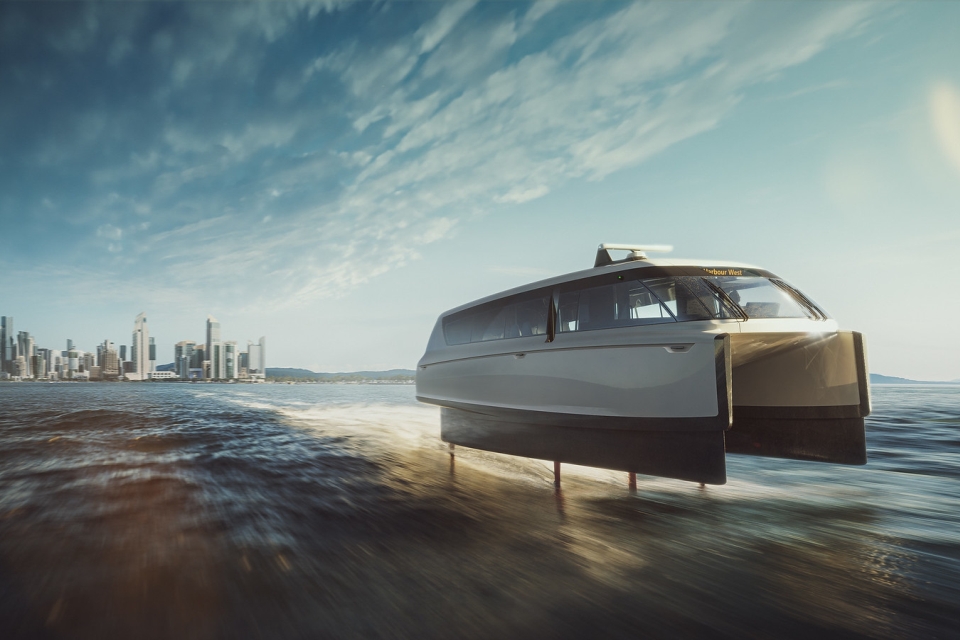The Candela P-12 Shuttle is set to hit Stockholm’s waters next year. The innovative hydrofoiling electric ferry will reduce emissions and slash commuting time. Stockholm hopes the ferry will make waterborne public transport more attractive than trains, buses, and cars.
The marine technology company Candela has now released the first pictures of what it says is the world’s fastest, longest-range and most energy efficient electric ship ever. The Candela P-12 Shuttle, as it is called, will be shuttling citizens between the sprawling Stockholm suburb of Ekerö and the city centre in the coming year.
Currently, this is a 55-minute trip by bus, subway, or conventional ferry (or even car during rush hour), while the Candela P-12 Shuttle will cover the 15-km route in only 25 minutes.
Flying across the water, the thirty-passenger electric vessel has a speed of thirty knots – considerably faster than any other electric ship in the world. It also provides faster commuting than the subway and bus lines it competes with, as well as being more energy efficient than the diesel vessels currently servicing the same route. Perhaps most signficant, the ship is faster than travelling by car during rush hour.
Also read: Watch Candela’s fully electric hydrofoil boat in action
Three carbon fibre wings
The secret to its high speed and long range are the three carbon fibre wings that extend from under the hull. These active hydrofoils allow the ship to lift itself above the water, thus decreasing drag.
Candela’s technology is said to reduce energy per passenger kilometer by 95 per cent compared to current vessels, allowing for a range of 50 nautical miles at service speed. Using the equivalent of 0.1 kWh of electricity per passenger kilometer, the ship is more energy efficient than a hybrid electric bus. Also, with up to 200 kW DC charging, it can charge its battery in under one hour.
Most importantly, the carbon fibre foils will slash many commuters’ travel times in half.
Near zero wake and no sea sickness
As the hydrofoiling Candela P-12 Shuttle creates near zero wake, it has been granted an exemption from the 12-knot speed limit, allowing it to fly into the city centre without causing wave damage to other vessels or sensitive shorelines. In fact, the miniscule propeller wash is considerably smaller than the wake from conventional passenger ships travelling at slow speeds.
The first electric flying ferry will also elevate passenger experience to a new level, thanks to an advanced computer system. Those prone to seasickness will appreciate the extremely smooth ride in adverse weather. Flying silently above the waves, the Candela Flight Controller – a computer which regulates the hydrofoils 100 times per second – ensures a steady, smooth ride.
‘There’s no other ship that has this kind of active electronic stabilisation,’ says Erik Eklund, vice president commercial vessels at Candela. ‘Flying aboard the P-12 Shuttle in rough seas will feel more like being on a modern express train than on a boat: it’s quiet, smooth and stable.’
Nine-month trial in 2023
The Region of Stockholm will operate the first P-12 Shuttle ship for a nine-month trial period during 2023. If it meets the high expectations, the hope is that the city’s fleet of over seventy diesel vessels eventually will be replaced by P-12 Shuttles – but also that land transport from congested highways can shift to the waterways.
Also read: VIDEO: TU Delft Hydro Motion Team reveals latest hydrofoil hydrogen boat
Serial production
Candela will be laying the carbon fibre keel for the very first Candela P-12 Shuttle at the company’s new, automated factory in Rotebro, outside Stockholm, towards the end of 2022.
The first P-12 Shuttle will be followed by many more, as serial production ramps up at the company’s Rotebro factory. Using production methods already streamlined for Candela’s leisure boat manufacturing, Candela aims to eventually spit out hundreds of P-12 Shuttles a year.
The specs of the P-12 shuttle are:
- Length: 11.99 metres
- Beam: 4.5 metres
- Weight: 8.5 tonnes
- Capacity: 30 passengers, seated
- Motor: 2 x Candela C-POD
- Batteries: 180 kWh
- Charging: up to 200 kW DC
- Top speed: 30 knots
- Service speed: 25-27 knots
- Range: 40-60 nautical miles at 25 knots service speed
Also read: Brittany Ferries eyes zero-emission, sea-skimming flying ferries








